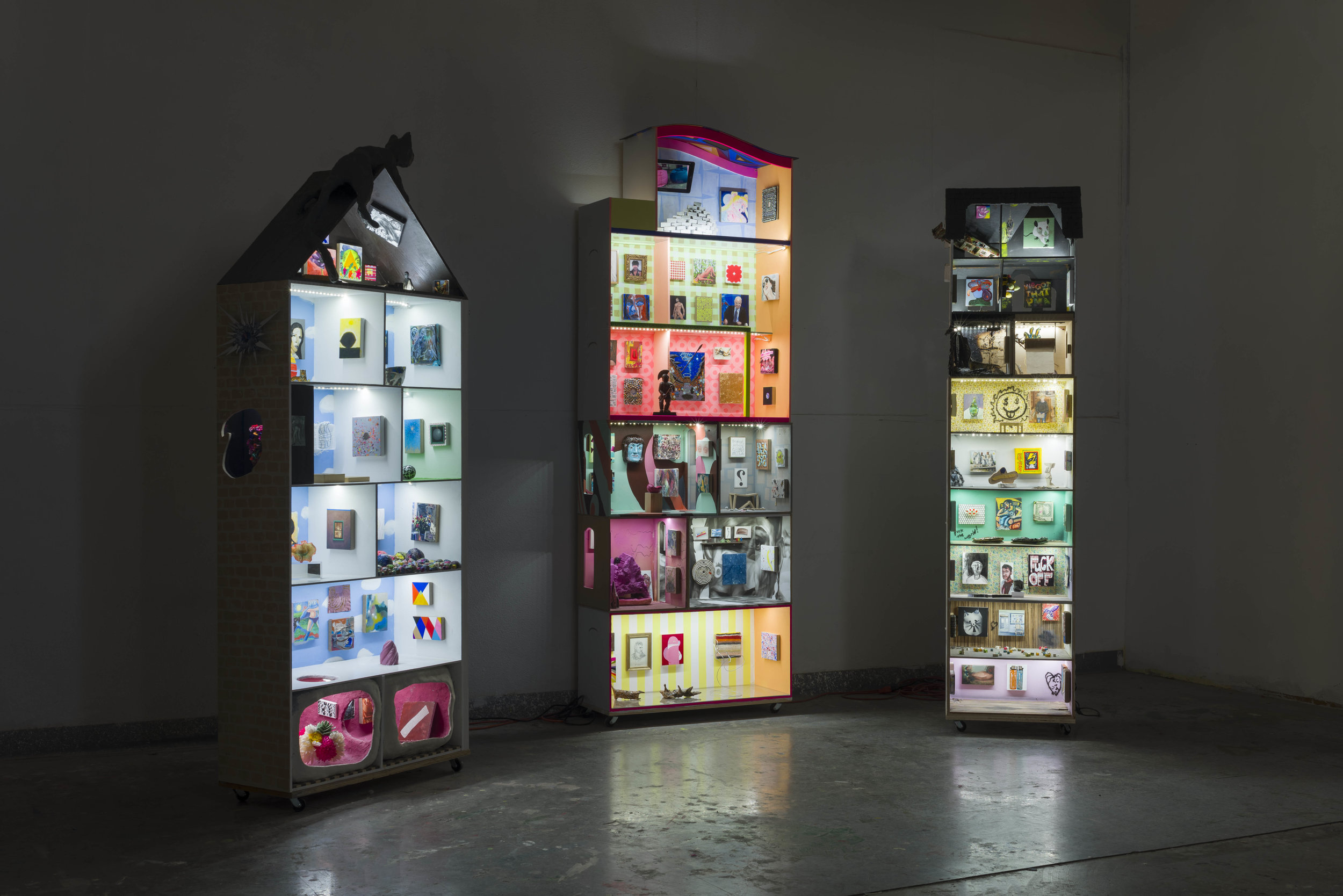Serious Topics
DREAMHOUSE VS. PUNK HOUSE
March 23 - September 29, 2019
Opening Reception: Saturday, March 23, 2 - 7 pm
Dreamhouse Vs. Punk House (plus Cat House)
Organized by Kristin Calabrese, Joshua Aster and Torie Zalben
March 23 - September 29, 2019
“The spirit of play is strong in LA.” – Anonymous
We each have our own ideas of house, home, structure, imaginative space. For Dreamhouse Vs. Punk House (plus Cat House), nearly 200 artists made perfect, small artworks to be shown in three highly decorated, 95-inch tall dollhouse towers.
The organizing principles were loose associations, lifelong acquaintances, new friends, artwork we’d love to own, the experimental and collaborative way that things happen in LA amongst artists – a think tank – an alternative to the daily grind of white walls and commercialism – artist run, pro artist, art forward. Let’s look and see!
Some inspirations include: Predator vs. Alien, Louise Bourgeois house drawings, James Castle structures, Barbie, America, the sixties, “Flowers in the Attic,” by V.C. Andrews, the 70s and the 80s, the present, art history, Hieronymus Bosch “Garden of Earthly Delights”, good vs. evil, which is which? Alice Konitz’ LAMOA, “Little Shop of Horrors.”… etc., doodles on napkins, and the wallpaper from the Magritte exhibition at LACMA.
These are the artists:
Aaron Axelrod, Abdul Mazid, Adam Miller, Adrienne Adar, Alice Könitz, Alison Blickle, Amada Claire Miller, Amanda Joy Calobrisi, Amy Adler, Amy Sarkissian, Andrew Falkowski, Andy Moses, Annabel Osberg, Anne Harris, Annie Lapin, Ariana Papademetropolis, Ave Pildas, Becky Kolsrud, Ben Jackel, Ben White, Bettina Hubby, Brad Eberhard, Brenna Youngblood, Brian Bowensmith, Brian Cooper, Caitlin Lonegan, Camilla Taylor, Carl Baratta, Carmen Argote, Carolyn Castaño, Charles Karubian, Charlotta Westergren, Chris Finley, Christian Haub, Christine Frerichs, Chung Park, Claire Chambless, Cole Case, Conrad Ruiz, Cyril Kuhn, Daniel Cummings, Dana Weiser, Danny First, Danny Shapiro, Darius Airo, Dave Muller, David Bronstein, Delia Brown, Denny Tentindo, Don Suggs, Doug Crocco, Dustin Metz, Eamon Ore-Giron, Elizabeth Tremante, Emily Joyce, Emma Gray, Eric Lebofsky, Eric Wesley, Faris McReynolds, Forrest Kirk, Fran Siegel, Frank Ryan, Frank Stockton, Georganne Deen, Heather Brown, Helen Rebekah Garber, Henry Taylor, Heriberto Luna, Hilary Baker, Holly Topping, Ian Trout, Iva Gueorguieva, Jane Goren, Jasmine Little, Jay Erker, Jayme Odgers, Jeni Spota C., Jennifer Rochlin, Jennifer Sullivan, Jesse Pace, Joe O’Neill, Joel Holmberg, John Mills, Jonathan Apgar, Josh Atlas, Joshua Aster, Joshua Miller, JP Munro, Julia Schwartz, Julia Sinelnikova, Juliana Romano, Kara Joslyn, Karin Gulbran, Karl Haendel, Katie Grinnan, Katie Herzog, Keith Mayerson, Keith Tolch, Keith Walsh, Kelly Berg, Kelly McLane and Jared Pankin, Kelly Neibert, Kenny Scharf, Kristin Calabrese, Krysten Cunningham, Kyla Hansen, Laura Krifka, Laurie Nye, Linda Stark, Lisa Adams, Logan Madsen, Lucas Reiner, Ludovico De Luigi, Margie Schnibbe, Mari Eastman, Marion Lane, Maripol, Mary Addison Hackett, Mary Anna Pomonis, Mary Weatherford, Matthew Fisher, Matthew Haywood, Max Jansons, Max Maslansky, Michal Kamran, Michelle Fierro, Michelle Grabner, Michiko Itatani, Mike Reesé, Mitchell Wright, Naotaka Hiro, Nathan Meier, Nasim Hantehzadeh, Ned Low, Nicholas Frank, Nicholas Shake, Nick Aguayo, Nik Irzyk, Nikko Mueller, Nikkolos Mohammed, Nina Bovasso, Opera Povera, Oscar Moreno, Patrick Woody, Paul Gillis, Paul Rusconi, Paz de la Huerta, Phyllis Green, Raffi Kalenderian, Rebecca Campbell, Rebecca Morris, Reed Anderson, Rema Ghuloum, Richard Hull, Rob Hill, Robert Fontenot, Robert Gunderman, Robert Russell, Rory Devine, Ross Rudel, Ryan Sluggett, Salomon Huerta, Samantha Fields, Sarah Awad, Scott Marvel Cassidy, Seffa Klein, Semra Sevin, Shana Lutker, Shiri Mordechay, Spencer Lewis, Stan Edmondson, Stephen Westfall, Stephanie Pryor, Steve Hurd, Steve Locke, Susan Logoreci, Susanna Coffey, Sydney Croskery, Tanya Batura, Tim Stark, Tom Allen, Tomory Dodge, Torie Zalben, Tyler Vlahovich, Vanessa Conte, Vera Milijkovic, Violet Hopkins, Zak Smith
Serious Topics is an artist run project space located at 1207 N. La Brea Ave., Down the Driveway, Inglewood, CA 90302. Gallery Hours are Monday through Friday 2 – 6 by appointment ONLY.
Email DreamhouseVsPunkhouse@gmail.com for appointment.
Our mailing address is:
Serious Topics1207 N La Brea Ave Ste 300Inglewood, CA 90302-1214



